Midsummer “To Do” List
Maintenance, Pruning
For many gardeners, spring is the critical gardening season, what with preparing the soil, starting seedlings, setting out transplants, pruning, watching and staying prepared for late frosts and . . . In my view, right now is just as crucial, and for an equal number of reasons.
True, a 90 degree day with high humidity doesn’t exactly pull you out to the garden to putter around in blazing sunlight. But early mornings around here are mostly cool, calm, and beautiful.
Much of what needs to be done is regular maintenance. Pruning tomatoes, for instance.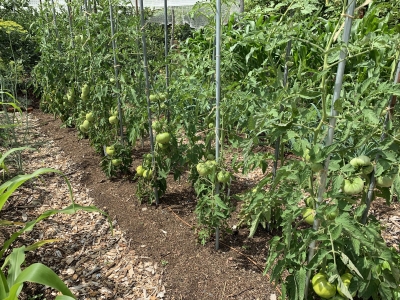 I train my tomato plants to stakes and single stems, which allows me to set plants only 18 inches apart and harvest lots of fruit by utilizing the third dimension: up. At least weekly, I snap (if early morning, when shoots are turgid) or prune (later in the day, when shoots are flaccid) off all suckers and tie the main stems to their metal conduit supports.
I train my tomato plants to stakes and single stems, which allows me to set plants only 18 inches apart and harvest lots of fruit by utilizing the third dimension: up. At least weekly, I snap (if early morning, when shoots are turgid) or prune (later in the day, when shoots are flaccid) off all suckers and tie the main stems to their metal conduit supports.
Espalier is the training of trees to two dimensions whereby the tracery of the stems is as decorative a plant feature as are the leaves, flowers, and/or fruits. To maintain that tracery of branches, my espaliered Asian pears need frequent pruning. 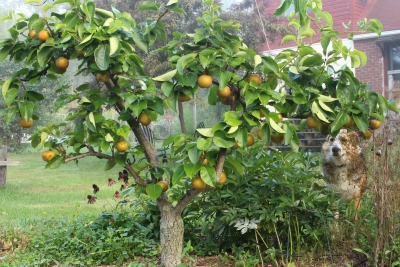 I lop wayward shoots either right back to their origin or, in hope of their forming “spurs” on which will hang future fruits, back to the whorl of leaves near the bases of the shoots.
I lop wayward shoots either right back to their origin or, in hope of their forming “spurs” on which will hang future fruits, back to the whorl of leaves near the bases of the shoots.
The response of the pear trees depends on the weather, which is unpredictable. Dry sunny weather is conducive to spurs. Rainy weather coaxes, instead, new shoots pop out right where I cut back old shoots. I think.
Maintenance, Water
Whether or not the weather is dry, rampant growing plants quickly suck the soil dry. So I also keep attentive to watering this time of year. The vegetable garden and potted plants are the neediest in this respect; fortunately, they demand little from me to do because a timer turns its drip irrigation system on and off automatically. All I have to do is to periodically check to make sure drippers are all dripping. 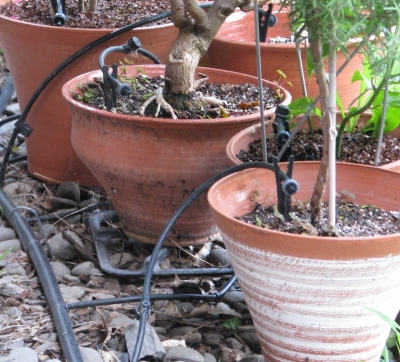 Newly planted trees and shrubs are another story. This first year, while their roots are spreading out in the ground, is critical for them. I make a list of these plants each spring and then water them weekly by hand all summer long unless the skies do the job for me (as measured in a rain gauge because what seems like a heavy rainfall often has dropped surprisingly little water).
Newly planted trees and shrubs are another story. This first year, while their roots are spreading out in the ground, is critical for them. I make a list of these plants each spring and then water them weekly by hand all summer long unless the skies do the job for me (as measured in a rain gauge because what seems like a heavy rainfall often has dropped surprisingly little water).
A one-inch depth of water is needed to wet a soil about a half a foot deep. I provide this with 3/4 gallon of water per estimated square foot spread of the roots.
Fall preps
Sowing seeds and setting out transplants isn’t only a spring gardening activity. Tomatoes, peppers, eggplants, cucumbers, and other summer vegetables peter out during the shorter, cooler days of late summer and early fall. But there are plenty of vegetables that enjoy growing conditions that time of year.
Some of the fall vegetables need to be sown now to be large enough to mature in fall. No need to provide space for them by digging out tomatoes, peppers, or any other summer vegetables. I sow endive, kale, lettuce, Chinese cabbage, and, if I could stomach it, cauliflower seeds in midsummer in seed flats. Once they sprout I “prick them out” into individual cells of automatic watering GrowEase trays for later transplanting. 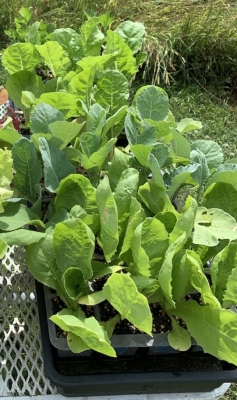 Not only vegetables get this treatment. Buy a packet of seeds of delphinium, pinks, or some other perennial, sow them now, overwinter them in a cool place with good light, or a cold (but not too cold) place with very little light, and the result is enough plants for a sweeping field of blue or pink next year. Sown in the spring, they won’t bloom until their second season even though they’ll need lots of space that whole first season.
Not only vegetables get this treatment. Buy a packet of seeds of delphinium, pinks, or some other perennial, sow them now, overwinter them in a cool place with good light, or a cold (but not too cold) place with very little light, and the result is enough plants for a sweeping field of blue or pink next year. Sown in the spring, they won’t bloom until their second season even though they’ll need lots of space that whole first season.
Cuttings are another way to propagate plants this time of year. Early this morning, when cells were plump with water, I made cuttings of hardy kiwifruit and begonia.
And, Yes, Weeds
Weeds can make all this pruning, watering, and seeding for naught. Clear ground is needed in which to eventually set my cabbage and kale transplants. Weeds stealing water and nutrients, even sunlight, won’t let plants grow at their best. They’ll also promote disease by preventing free flow of air; fungi fester under damp conditions. 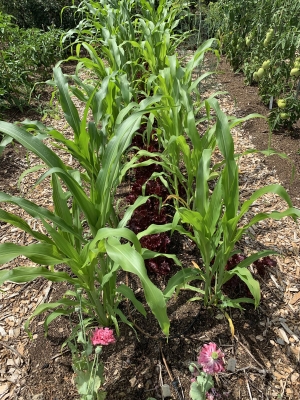 Every time I look at a weed, I’m thinking how it’s either sending roots further afield underground or is flowering (or will flower) to scatter its seed. Much of gardening isn’t about the here and now, so I also weed now for less weeds next season. It’s worth it.
Every time I look at a weed, I’m thinking how it’s either sending roots further afield underground or is flowering (or will flower) to scatter its seed. Much of gardening isn’t about the here and now, so I also weed now for less weeds next season. It’s worth it.



I’ve been using 2×2 wooden stakes as tomato poles because they’re cheap and have worked well for the past decade (replaced about every 5 years), but I wonder if they harbor more pests (especially fungus) from season to season than a material like metal. Should I switch to metal conduit the next time I replace them?
The wooden posts are probably fine as far as pests. But the metal posts are cheap, last for many, many years and are super-easy to pound into the ground.
Great tip, thanks!
Great summary of tomato-growing methods! The hardest part for me to follow is the extensive pruning–makes me feel that I’m being cruel to those “poor” multistemed plants. But as often happens, plants can be more logical than I’ll ever be.
Please share your experience of controlling/avoiding fungus (early blight and similar) on tomatoes and cucumbers.
Thank you.
Crop rotation, thorough cleanup at the end of the season, mulch (1″ of compost), good air circulation and sunlight, and some luck. There have been years where fungal diseases were worse than other. As for any disease, severity is dependent on environmental conditions, host plant susceptibility, and presence of pathogen. I do what I can. This year, despite all the rain, diseases seem mild.
Thank you for the list. I think, I follow all of them and thought you might have a “magic touch”. 🙂 In addition, I don’t have much luxury of crop rotation as my garden is relatively small.
This year I decided to do an experiment, as I read that fungus spores are carried by wind. I made a clear plastic enclosure, about 5′-6″ tall, covering just one row of tomatoes. Bottom of the enclosure is open about 2 feet from the ground, and I decided to not spray fungicide on that row. So far (2 weeks), bottom branches remaining after pruning, about 12-18 inches from the ground, did get infected by the early blight. Whatever is above is clear. The other row does get infected more than just above of that height, but I cut infected branches and spray fungicide.
Hmmm. I’ve never had to spray my tomatoes (except for the bad blight year years ago when, joining the panic, I “followed the crowd” and sprayed). Late blight spores are wind carried but spores of the other two major leaf spotting diseases — septoria and early blight — overwinter on old plant material. A very thorough cleanup at the end of the season plus mulching (with compost, in my garden) should go a long way to helping to control these diseases.
I do remove all the tomatoes roots in fall. I don’t compost, but cover the rows with about 2″ thick shredded straw layer. Nevertheless, a fungus is present every year.
What is the reason for “good air circulation”? Reduction of condensation and faster removal of after rain moisture on the leaves?
My experiment with narrow tunnel like cover indicates that it doesn’t help to reduce fungus vs. the open row. Apparently, due to extended presence of air condensate as a result of the reduced air circulation. It protects from rain moisture, but allows the condensate to remain longer. So, ideally, it should be removable, which, unfortunately, isn’t always practical.
It’s not possible, even with very thorough cleanup, to get rid of all fungal spores.
Good air circulation (and sunlight) promote more rapid drying of plant surfaces so that fungi have less time to get established.
Whether or not condensation forms on leaves overnight depends on cloud cover. If the night is clear, more should form on uncovered tomatoes. Under humid conditions, more would form under cover. A higher tunnel would help as would (although not practical for you setup, it seems) a fan. In my greenhouse, I run a fan continuously.
Continue to have trouble w/ Japanese beetles on my blueberries. I pick them daily and feed them to the chickens [like candy]. They are ruining many of the ripened berries. Any suggestions?
Thank you
I’m not sure why I don’t get the beetles anymore. Also, my chickens never liked eating them. Fine netting, maybe?
If suckers are missed and become very large do you still prune them? Or at that point does the negative “shock to the plant” of cutting out such a big portion outweigh the benefit of “channelling energy”?
Yes, I still prune them. If I let them go, the planting get too congested. I don’t think it shocks the plants — tomatoes grow like weeds in warm weather.
Looking at your picture with tomatoes, how do you avoid them burning by sun? They seem like fully exposed.
I think burning only occurs if, once shaded, they are then exposed to full sunlight. Loss of shade might result from infrequent pruning or leaf loss from disease.
What type of conduit do you buy for stakes/where do you buy it? Thanks!
EMT 1/2 or 5/8″ electrical conduit, available at any building supply store, such as Lowes.
When you overwinter July sowed delphs indoors – do you water them in the winter? I assume the cold + dark (vs cool + light) would get less water, or?
Thank you!
As always, I water as needed. The soil must remain moist.